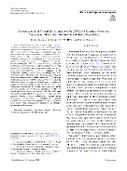Characterization of Stronghold Fortifications by 2D/3D/4D Electrical Resistivity Tomography: Major Push Towards Quantitative Interpretation

Publication date
2024Published in
Pure and Applied GeophysicsVolume / Issue
181ISBN / ISSN
ISSN: 0033-4553ISBN / ISSN
eISSN: 1420-9136Metadata
Show full item recordCollections
This publication has a published version with DOI 10.1007/s00024-024-03427-x
Abstract
Geophysical methods are widely used as noninvasive tools for archaeological prospection. In a first step is usually applied basic prospection of vast areas, when data are evaluated only in qualitative way. Sometimes is performed second step, during which take place more detailed multidimensional or combined surveys in order to image archeological monuments complexly, allowing quantitative interpretation. Hence, we used a unique and novel combination of multidimensional electrical resistivity tomography (ERT) on the Early Middle Ages stronghold fortifications at Vinorv (Czechia) to achieve such interpretation. The joint results of 2D/3D/4D (time-lapse) surveys allowed us to precisely characterize individual construction components of the fortifications, including a ditch and rampart enhanced by a front wall with a berm. The ERT results recovered the fortification dimensions and the volume of building material used. The surveyed fortification section was verified by excavations directly after the ERT measurements. A comparison of the excavated section with geophysics proved that ERT was able to infer all the important fortification characteristics. In addition, illustrative picture of the resistivity manifestations of the basic components of this very typical fortification construction were obtained. The results show that multidimensional ERT provide access to quantitative interpretation allowing to explain archaeological structures behind investigated anomalies. In result, sites containing cultural heritage can be leaved intact, excavations can be substituted in surprisingly large extent, while unprecedented amount of archaeological information is still retrieved.
Keywords
stronghold, fortification, Electrical Resistivity, Tomography, quantitative, 4D ERT, archaeology
Permanent link
https://hdl.handle.net/20.500.14178/2569License
Creative Commons Uveďte původ 4.0 International






